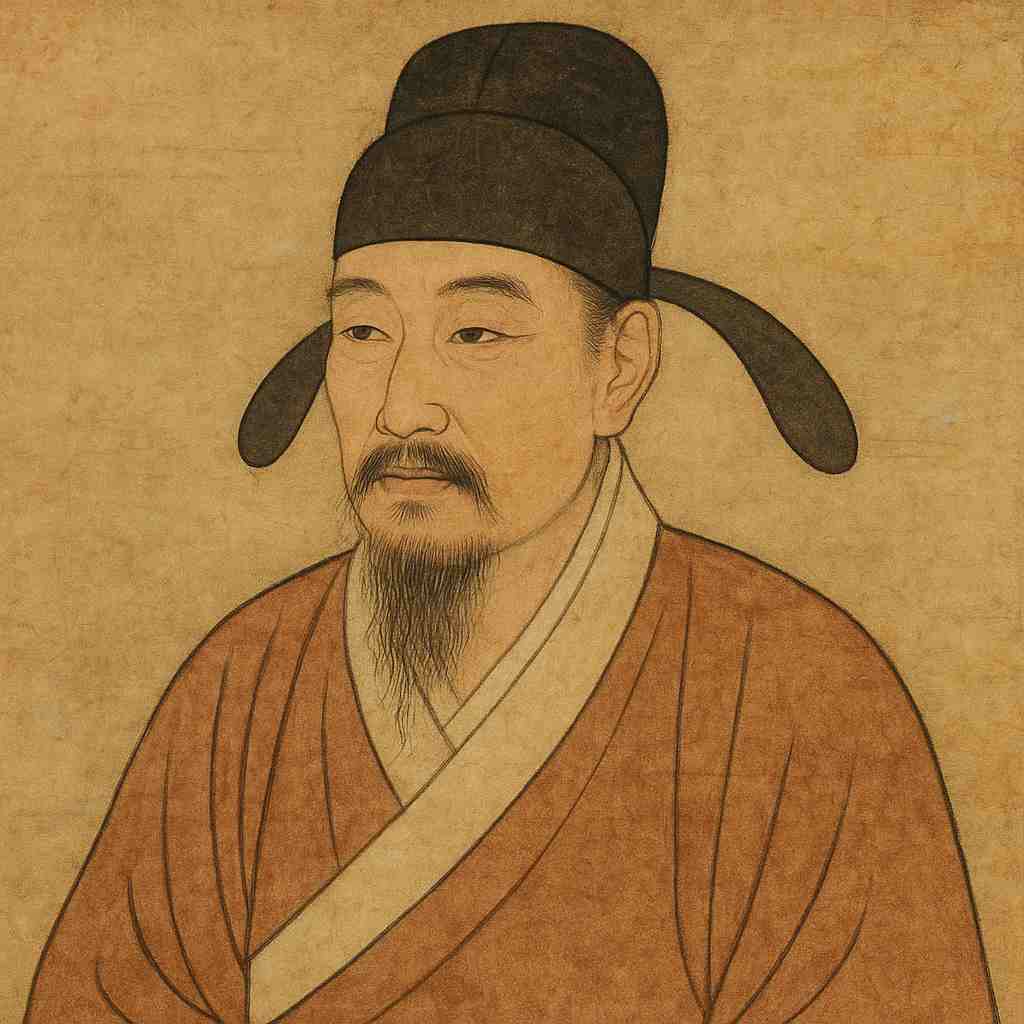1 Poems by Ch'ŏyong
c. 800 - c.900
Ch'ŏyong Biography
The figure of Ch'ŏyong, or Cheoyong, stands as a fascinating confluence of Korean mythology, folklore, and poetry, a figure whose story has permeated Korean cultural consciousness for over a millennium. Ch'ŏyong’s tale originates in the Silla dynasty (57 BCE–935 CE), a period rich in both cultural flowering and mystical storytelling, and it has continued to resonate throughout the evolution of Korean literature and traditional practices. Although Ch'ŏyong is often regarded primarily as a legendary figure, his story is connected to one of the oldest examples of recorded Korean poetry, “Ch'ŏyongga” or “The Song of Ch'ŏyong,” which embodies themes of resilience, mysticism, and the warding off of evil. To fully appreciate the significance of Ch'ŏyong in Korean culture, it is essential to delve into his story, its symbolic meanings, and the historical context that has preserved his legend for generations.
Ch'ŏyong’s legend is rooted in the city of Gyeongju, the capital of the Silla dynasty and a center for Buddhist art, scholarship, and culture. According to legend, Ch'ŏyong was the son of a dragon king who ruled over the Eastern Sea. He was a handsome, graceful, and talented young man with a gift for singing and dancing. One night, after a long day of festivities, Ch'ŏyong returned to his home only to find his wife in bed with a malevolent spirit, often identified as a plague demon. Instead of responding with violence or anger, Ch'ŏyong sang a song to the demon, accepting the reality of the situation but also subtly asserting his rights and desires. In response to his graceful and forgiving approach, the demon was so moved by Ch'ŏyong’s composure that he vowed never to enter a house where Ch'ŏyong’s face was displayed. This myth gave rise to a tradition of placing images of Ch'ŏyong on doorways and gates as talismans to ward off disease and misfortune, a custom that continues in some Korean households even today.
The song Ch'ŏyong sang, known as “Ch'ŏyongga,” is one of the oldest known Korean poems, with a powerful simplicity that underscores the significance of both Ch'ŏyong’s acceptance and the symbolism embedded in the legend. The lines of “Ch'ŏyongga” as recorded are brief but resonate with deeper layers of meaning. Translated from Middle Korean, it reads:
"Having merrily enjoyed the moonlit night,
I return home to find four legs in my bed.
Two belong to me; whose are the other two?
Formerly, those two belonged to me as well.
Now that I see them in another’s embrace,
What is the use of anger?"
The poem captures Ch'ŏyong’s response, marked by a profound sense of calm and acceptance. In an era when societal norms prescribed rigid codes of behavior, especially regarding marriage and fidelity, the non-confrontational stance of Ch'ŏyong’s character is both unexpected and profound. Rather than seeking revenge or retribution, he instead embodies a transcendent wisdom, recognizing the transitory nature of life and material attachments.
Scholars have long debated the underlying significance of “Ch'ŏyongga,” as its lines seem deceptively simple yet are filled with symbolic nuances. The presence of a demon in Ch'ŏyong’s bed represents not just an act of marital betrayal, but a transgression of cosmic order, where supernatural forces interfere with the human realm. Ch'ŏyong’s calm acceptance of this situation suggests a spiritual maturity and a profound connection to the Buddhist teachings that permeated Silla society. During the Silla period, Buddhism was not only a state religion but also an ideological force that influenced literature, art, and daily life. The Buddhist undertones in “Ch'ŏyongga” are subtle yet clear, as Ch'ŏyong’s response aligns with Buddhist principles of non-attachment and the transcendence of earthly desires and anger.
The historical origins of the Ch'ŏyong story and the “Ch'ŏyongga” poem are linked to Silla’s complex relationship with both native shamanistic practices and imported Buddhist beliefs. The Silla period, while heavily influenced by Buddhism, also maintained deep-rooted shamanistic traditions, which included rites and chants to protect against disease and misfortune. In this context, Ch'ŏyong emerges as a syncretic figure, embodying elements of both Buddhist and shamanistic paradigms. His role as a deity of protection is reflected in the practice of painting or carving his face onto doors, often depicted with an exaggerated smile and a broad-brimmed hat, an image believed to scare away evil spirits. Thus, Ch'ŏyong serves as a guardian figure, symbolizing the integration of cultural beliefs from diverse sources within the uniquely Korean worldview of the time.
The legacy of Ch'ŏyong and his song persisted through Korea’s dynastic changes, from Silla to Goryeo and into the Joseon dynasty, with each era interpreting his legend according to its values and needs. During the Goryeo dynasty (918–1392), a period characterized by the expansion of Buddhism and increasing contact with neighboring cultures, Ch'ŏyong’s image became even more deeply associated with exorcistic rituals. The Goryeo court institutionalized the “Ch'ŏyongmu,” or “Dance of Ch'ŏyong,” a ceremonial dance performed to drive away evil spirits and protect the kingdom from plagues. This dance became a key part of Goryeo’s royal court culture, performed during times of crisis to invoke Ch'ŏyong’s protective powers. By invoking Ch'ŏyong in this way, the Goryeo rulers reinforced the symbolic connection between Ch'ŏyong’s legend and the well-being of the nation, transforming an ancient myth into an instrument of state-sponsored spirituality.
With the arrival of the Joseon dynasty (1392–1897), Confucianism became the state ideology, and many Buddhist and shamanistic practices were suppressed. However, the legend of Ch'ŏyong survived, albeit in a slightly altered form. The Joseon dynasty’s Confucian ideals emphasized moral rectitude and social order, and Ch'ŏyong’s story was reinterpreted to highlight virtues like loyalty, restraint, and self-control, aligning with Confucian values. The “Ch'ŏyongmu” dance continued to be performed, although with modifications to fit the Confucian ethos. In this new interpretation, Ch'ŏyong became a model of virtuous conduct, his reaction to betrayal seen as an exemplar of Confucian composure rather than a purely spiritual acceptance.
In modern Korea, Ch'ŏyong remains a potent cultural symbol, representing the resilience and adaptability of Korean identity. His story and song continue to inspire reinterpretations in literature, art, and dance. The “Ch'ŏyongmu” is still performed today, recognized as an Intangible Cultural Heritage by UNESCO. The dance, with its hypnotic rhythm and stylized movements, serves as a powerful reminder of Korea’s ancient traditions and the ongoing relevance of its mythological heritage. In contemporary Korea, Ch'ŏyong is not only a historical or mythological figure but a symbol of cultural continuity, embodying values of peace, acceptance, and the triumph of wisdom over impulse.
In the broader spectrum of Korean literature and folklore, the tale of Ch'ŏyong highlights Korea’s longstanding fascination with the supernatural and its rich tapestry of protective deities. The popularity of Ch'ŏyong in Korean cultural memory reflects a collective yearning for protection and peace amid life’s uncertainties. His figure straddles the lines between deity and human, embodying the enduring belief in the power of song, dance, and art to not only confront but to transcend suffering and misfortune. Through his acceptance and grace, Ch'ŏyong teaches an ancient yet timeless lesson on the power of compassion and the ultimate futility of anger and vengeance.
To this day, the image of Ch'ŏyong and the performance of “Ch'ŏyongmu” serve as reminders of the Korean spirit’s resilience and adaptability, traits that have allowed Korean culture to withstand centuries of change while holding onto its unique and profound heritage. The simplicity and beauty of “Ch'ŏyongga” remain resonant, reminding us of a world where poetry, music, and wisdom are weapons stronger than anger or retribution, a sentiment that continues to inspire and protect those who remember Ch'ŏyong’s story.
This text was generated by AI and is for reference only. Learn more
Username Information
No username is open
Everything is free to use, but donations are always appreciated.
Quick Links
© 2024-2025 R.I.Chalmers (V2Melody).

All music on this site by R.I.Chalmers (V2Melody) is licensed under a Creative Commons Attribution-NonCommercial 4.0 International License.
Attribution Requirement:
When using this music, you must give appropriate credit by including the following statement (or equivalent) wherever the music is used or credited:
"Music by R.I.Chalmers (V2Melody) – https://v2melody.com"
Support My Work:
If you enjoy this music and would like to support future creations, your thanks are always welcome but never required.
Thanks!


